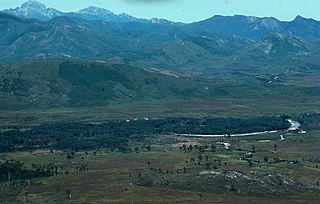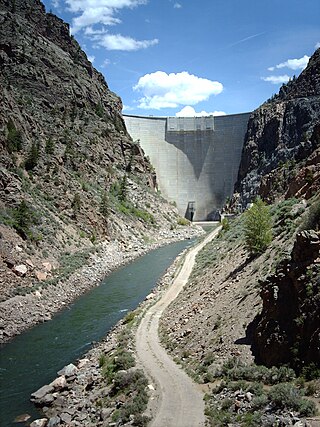Serpentine may refer to:
Serpentine may refer to:

The River Derwent, also known as timtumili minanya in palawa kani, is a significant river and tidal estuary in Tasmania, Australia. It begins its journey as a freshwater river in the Central Highlands at Lake St Clair, descending over 700 metres (2,300 ft) across a distance of more than 200 kilometres (120 mi). At the settlement of New Norfolk in the Derwent Valley its waters become brackish, flowing through Hobart, the capital city of Tasmania, its seawater estuary eventually empties into Storm Bay and the Tasman Sea.

Serpentine subgroup are greenish, brownish, or spotted minerals commonly found in serpentinite. They are used as a source of magnesium and asbestos, and as decorative stone. The name comes from the greenish color and smooth or scaly appearance from the Latin serpentinus, meaning "snake-like".

Lake Pedder, once a glacial outwash lake, is a man-made impoundment and diversion lake located in the southwest of Tasmania, Australia. In addition to its natural catchment from the Frankland Range, the lake is formed by the 1972 damming of the Serpentine and Huon rivers by the Hydro-Electric Commission for the purpose of hydroelectric power generation. Consequently, the lake is also known, somewhat derisively, as the Huon-Serpentine Impoundment.

The Gordon River is a major perennial river located in the central highlands, south-west, and western regions of Tasmania, Australia.

The King River is a major perennial river in the West Coast region of Tasmania, Australia.
Bass or Basses may refer to:

An arch dam is a concrete dam that is curved upstream in plan. The arch dam is designed so that the force of the water against it, known as hydrostatic pressure, presses against the arch, causing the arch to straighten slightly and strengthening the structure as it pushes into its foundation or abutments. An arch dam is most suitable for narrow canyons or gorges with steep walls of stable rock to support the structure and stresses. Since they are thinner than any other dam type, they require much less construction material, making them economical and practical in remote areas.
BlackRock is a global investment management firm.
Olegas Truchanas was a Lithuanian-Australian conservationist and nature photographer.

Ultramafic rocks are igneous and meta-igneous rocks with a very low silica content, generally >18% MgO, high FeO, low potassium, and are composed of usually greater than 90% mafic minerals. The Earth's mantle is composed of ultramafic rocks. Ultrabasic is a more inclusive term that includes igneous rocks with low silica content that may not be extremely enriched in Fe and Mg, such as carbonatites and ultrapotassic igneous rocks.

Serpentinite is a metamorphic rock composed predominantly of one or more serpentine group minerals formed by near to complete serpentinization of mafic to ultramafic rocks. Its name originated from the similarity of the texture of the rock to that of the skin of a snake. Serpentinite has been called serpentine or serpentine rock, particularly in older geological texts and in wider cultural settings.

The Lyell Highway is a highway in Tasmania, running from Hobart to Queenstown. It is the one of two transport routes that passes through the West Coast Range, the other being the B28 Anthony Road.
A pyramid is a structure with triangular lateral surfaces converging to an apex.
A wheel is a circular device that is capable of rotating on an axle.

The Tarraleah Power Station is a hydroelectric power station located in the Central Highlands region of Tasmania, Australia. The power station is part of the Upper Derwent hydro scheme and is operated by Hydro Tasmania.

Heazlewoodite, Ni3S2, is a rare sulfur-poor nickel sulfide mineral found in serpentinitized dunite. It occurs as disseminations and masses of opaque, metallic light bronze to brassy yellow grains which crystallize in the trigonal crystal system. It has a hardness of 4, a specific gravity of 5.82. Heazlewoodite was first described in 1896 from Heazlewood, Tasmania, Australia.
Lateritic nickel ore deposits are surficial, weathered rinds formed on ultramafic rocks. They account for 73% of the continental world nickel resources and will be in the future the dominant source for the mining of nickel.
The Lachlan Fold Belt (LFB) or Lachlan Orogen is a geological subdivision of the east part of Australia. It is a zone of folded and faulted rocks of similar age. It dominates New South Wales and Victoria, also extending into Tasmania, the Australian Capital Territory and Queensland. It was formed in the Middle Paleozoic from 450 to 340 Mya. It was earlier known as Lachlan Geosyncline. It covers an area of 200,000 km2.
The Serpentine River is a major perennial river located in the south-west and western regions of Tasmania, Australia.
Serpentine Dam may refer to: